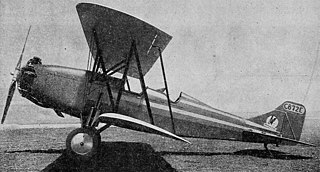Related Research Articles

The Buhl-Verville CA-3 Airster, was a utility aircraft built in the United States in 1926, notable as the first aircraft to receive a type certificate in the US, issued by the Aeronautics Branch of the Department of Commerce on March 29, 1927. It was a conventional single-bay biplane with equal-span unstaggered wings and accommodation for the pilot and passengers in tandem open cockpits. Marketed for a variety of roles including crop-dusting, aerial photography, and freight carriage, only a handful were built, some with water-cooled engines as the CW-3, and others with air-cooled engines as the CA-3. One CA-3 placed second in the 1926 Ford National Reliability Air Tour.

The Spartan C3 is an American three-seat open-cockpit utility biplane from the late 1920s.

The Stearman LT-1 was a late 1920s American biplane, carrying four passengers plus mail.
The Western Airplane King Bird, named after the tyrant flycatcher (Western) Kingbird, was a 1920s US civil transport accommodating three passengers in open cockpits. Only one was built.

The NAS Air King was a US light biplane transport aircraft designed in 1926 to carry three passengers in two open cockpits. Only one was built but in 1928 it was revised to carry two passengers and was more successful, with over twenty produced.
The Brown 1926 parasol monoplane was a 1920s US, three seat, parasol wing civil aircraft developed from a biplane wartime scout. It was intended for either the private or commercial passenger markets, though one was used as a crop-duster.

The Hamilton H-18 was a 1920s US four/five passenger aircraft. An early all-metal design, it reflected Junkers and Stout design practices. Though it won safety and efficiency awards only one was built.
The Yackey Monoplane was an American three seat parasol monoplane flown in the late 1920s. Two prototypes had some success in the 1927 New York - Spokane National Air Derby and orders were placed but a crash killed its designer and ended production.

The Thunderbird W-14 was a small, three seat American passenger transport, first flown in 1926, entering production, significantly improved, in 1927 with several different engine options. About 40-50 were built before the financial collapse of the company in 1929.

The Laird LC-B was a three seat, single-engined biplane, built for private owners in the U.S. in the late 1920s and offering a variety of engines. About 35 had been built before production ceased in the mid-1930s. Two have been restored to flight.
The Stiles Dragon Fly was an American two seat monoplane aircraft of the late 1920s. It was aimed at private and club owners. Significant production was planned but few were built.
The Pacer Monoplane was a parasol wing, four seat, light aircraft, flown and produced in the US in the late 1920s.
The Simplex Red Arrow was a US single-engined monoplane produced in the late 1920s and early 1930s and intended as club machine or mail transport. Most used radial engines in the 90–110 hp (67–82 kW) range. They carried one or two passengers whose seats could be open or enclosed. One variant, the Red Arrow Dual Plane, was easily converted from monoplane to biplane and was available with two versions of the much more powerful Wright Whirlwind engines. In all about 20 were built.

The 1929 Curtiss Model 53 Condor, also known as the Curtiss Model 53 Condor 18 or the Curtiss CO Condor, was a civil passenger version of the Model 52 Condor bomber. A twin-engined biplane, it carried 18 passengers.

The American Eagle Phaeton was an American three seat, single engine sports biplane produced from 1929 until American Eagle failed financially in 1932. About 34 were built.

The Wallace Touroplane was a late 1920s U.S. three seat, high wing cabin monoplane. About 20 were built.
The Hodkinson HT-1 was a U.S., eight place, three-engined sesquiplane, first flown in 1929. Despite an order for five, only one had been completed before Hodkinson Aircraft went bankrupt near the start of the Great Depression. It operated in Guatemala for several years.

The Ireland Neptune was a four or five place pusher configuration biplane sold in flying boat and amphibian versions. Designed in the U.S. and first flown in 1927, well over 50 were built.

The Zenith Z-6 is a single engine biplane U.S. airliner built in the late 1920s. Its cabin, in the fuselage immediately behind its radial engine, holds five or six passengers depending on engine power. It is flown from an open cockpit further aft. Nine were completed and one has been restored to flight.

The Huff-Daland HD.8A was a small civil transport biplane carrying two passengers built in the U.S. in 1922. The otherwise identical HD-9A offered an alternative engine.
References
- ↑ "Aerofiles" . Retrieved 25 February 2020.
- 1 2 3 4 5 "The Hess Blue Bird". Aviation Week. XXII (1): 680. 31 January 1927.
- 1 2 3 4 "The Blue Bird". Aero Digest. 10 (2): 136. February 1927.
- 1 2 3 4 Wesley R. Smith (20 July 2014). "The Alliance Argo A-1" . Retrieved 7 March 2021.
- ↑ "Hess advert". Aero Digest. 10 (1): 136. January 1927.
- 1 2 "Progress of Distance Flights". Aero Digest. 11 (6): 136. December 1927.
- ↑ "Images of 1926 Ford Reliability Tour contestants" . Retrieved 25 February 2020.
- ↑ "The 1927 National Air Tour". Aero Digest. 11 (1): 900. July 1927.